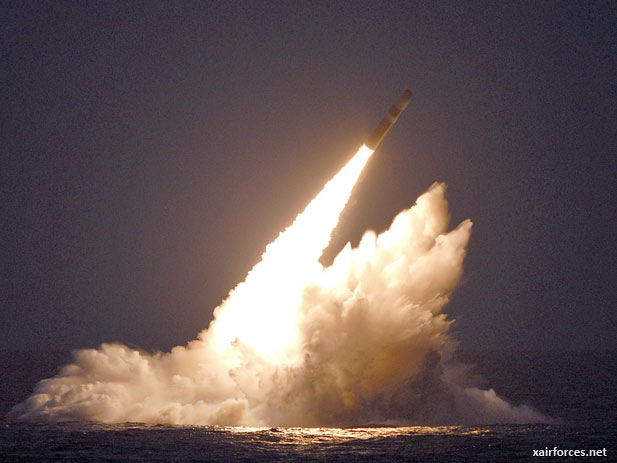
Trident II D5 Missile: Keeping Up with Changing Times

Nuclear tipped missiles were first deployed on board US submarines at the height of the Cold War in the 1960s, to deter a Soviet first strike.
The deterrence theorists argued that, unlike their land-based cousins, submarine-based nuclear weapons couldn’t be taken out by a surprise first strike, because the submarines were nearly impossible to locate and target. Which meant that Soviet leaders couldn’t hope to destroy all of America’s nuclear weapons before they could be launched against Soviet territory. SLBM/FBM (Submarine Launched Ballistic Missile/ Fleet Ballistic Missile) offered shorter ranges and less accuracy than their land-based ICBM (Inter-Continental Ballistic Missile) counterparts, but the advent of Trident C4 missiles began extending those ranges, and offering other improvements. The C4s were succeeded by larger Trident II D5 missiles, which added precision accuracy and more payload.
The year that the Trident II D5 ballistic missile was first deployed, 1990, saw the beginning of the end of the missile’s primary mission. Even as the Soviet Union began to implode, the D5’s performance improvements were making the Trident submarine force the new backbone of the USA’s nuclear deterrent – and of Britain’s as well. To ensure that this capability was maintained at peak readiness and safety, the US Navy undertook a program in 2002 to replace aging components of the Trident II D5 missile called the D5 Life Extension (LE) Program. This article covers D5 LE, as well as support and production contracts associated with the American and British Trident missile fleets.
D5 Life Extension Program:
But by the time the latest version of the submarine-launched ballistic missile was deployed, the existence of the Soviet Union itself was in doubt. The previous year, the Soviet’s Eastern European client states began to fall, symbolized by the destruction of the Berlin Wall. The Soviet Union itself began to crumble with various Soviet republics rebelling against the central government in 1990. Then, in 1991, a failed coup attempt against Soviet reformer Mikhail Gorbachev brought Boris Yeltsin to power, who promptly dissolved the Soviet Union.
The end of the Soviet Union and the easing of the Soviet first strike threat did not end the need for a nuclear deterrent. States like Russia and China still have them, North Korea is the first nuclear-armed rogue state but will not be the last, and non-state actors remain a potential threat, given instability in key countries like Pakistan. The US nuclear deterrent got smaller, but it did not go away – and as it became smaller, the importance of the Trident fleet only rose. Especially given Britain’s use of the same missiles as its sole nuclear deterrent.
The Trident C-4 has been in service since 1979, but the D-5 Trident II is more recent. First deployed in 1990 and scheduled for operational deployment until 2042, 12 of the USA’s 14 SSBNs have been outfitted with Trident II D-5 missiles, and the other 2 were scheduled to be back-fitted as opportunity permits.
The Trident II D5 LE Program is intended to extend the service life of the weapon system until 2042 to match the hull life of the Ohio-class submarine. Under the program, 108 additional missiles [PDF] are being purchased, in order to meet long-term inventory requirements.
The LE program involves updating the missile’s electronics, guidance and reentry systems. In particular, the Mk6 LE guidance system is a replacement for the aging Mk6 guidance system, which used 1980s technology that isn’t in production any more. The Next Generation Guidance (NGG) program aims to develop the Mk6 LE as a modern replacement that can achieve the same or better performance as the guidance systems that are breaking down. This requires development of precision instruments, sensors, and radiation hardened architectures, in order to adapt the underlying commercial technologies for use in a must-not-malfunction nuclear weapons system.
Source: 08 July 2012 (defenseindustrydaily.com)
Photo: The U.S. Trident II D5 Missile Test Launch (Photo by DoD Archive)
(8.07.2012)
|